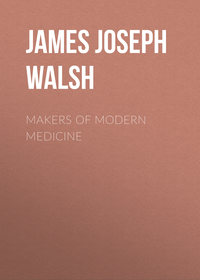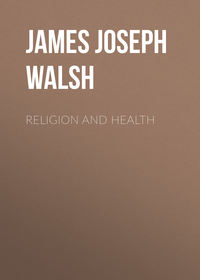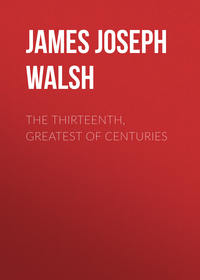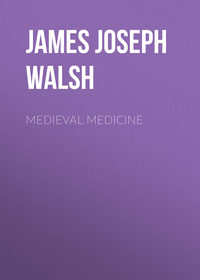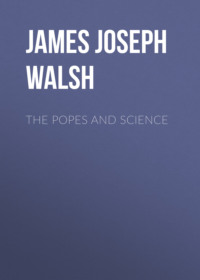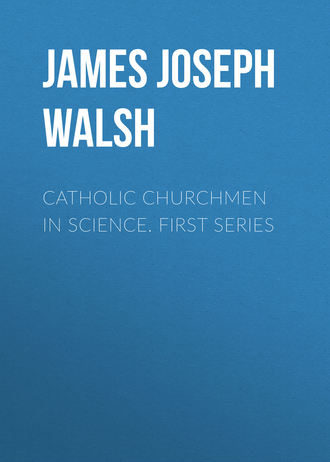 полная версия
полная версияCatholic Churchmen in Science. First Series

James J. Walsh
Catholic Churchmen in Science [First Series] / Sketches of the Lives of Catholic Ecclesiastics Who Were Among the Great Founders in Science
PREFACE
The following sketches of the lives of clergymen who were great scientists have appeared at various times during the past five years in Catholic magazines. They were written because the materials for them had gradually accumulated during the preparation of various courses of lectures, and it seemed advisable to put them in order in such a way that they might be helpful to others working along similar lines. They all range themselves naturally around the central idea that the submission of the human reason to Christian belief, and of the mind and heart to the authority of the Church, is quite compatible with original thinking of the highest order, and with that absolute freedom of investigation into physical science, which has only too often been said to be quite impossible to churchmen. For this reason friends have suggested that they should be published together in a form in which they would be more easy of consultation than when scattered in different periodicals. It was urged, too, that they would thus also be more effective for the cause which they uphold. This friendly suggestion has been yielded to, whether justifiably or not the reader must decide for himself. There is so great a flood of books, good, bad, and indifferent, ascribing their existence to the advice of well-meaning friends, that we poor authors are evidently not in a position to judge for ourselves of the merit of our works or of the possible interest they may arouse.
I have to thank the editors of the American Catholic Quarterly Review, of the Ave Maria, and of The Ecclesiastical Review and The Dolphin, for their kind permission to republish the articles which appeared originally in their pages. All of them, though substantially remaining the same, have been revised, modified in a number of particulars, and added to very considerably in most cases.
The call for a second edition–the third thousand–of this little book is gratifying. Its sale encouraged the preparation of a Second Series of CATHOLIC CHURCHMEN IN SCIENCE, and now the continued demand suggests a Third Series, which will be issued during the year. Some minor corrections have been made in this edition, but the book is substantially the same.
I.
THE SUPPOSED OPPOSITION OF SCIENCE AND RELIGION
A common impression prevails that there is serious, if not invincible, opposition between science and religion. This persuasion has been minimized to a great degree in recent years, and yet sufficient of it remains to make a great many people think that, if there is not entire incompatibility between science and religion, there is at least such a diversity of purposes and aims in these two great realms of human thought that those who cultivate one field are not able to appreciate the labors of those who occupy themselves in the other. Indeed, it is usually accepted as a truth that to follow science with assiduity is practically sure to lead to unorthodoxy in religion. This is supposed to be especially true if the acquisition of scientific knowledge is pursued along lines that involve original research and new investigation. Somehow, it is thought that any one who has a mind free enough from the influence of prejudice and tradition to become an original thinker or investigator, is inevitably prone to abandon the old orthodox lines of thought in respect to religion.
Like a good many other convictions and persuasions that exist more or less as commonplaces in the subconscious intellects of a great many people, this is not true. Our American humorist said that it is not so much the ignorance of mankind that makes him ridiculous as the knowing so many things "that ain't so." The supposed opposition between science and religion is precisely an apposite type of one of the things "that ain't so." It is so firmly fixed as a rule, however, that many people have accepted it without being quite conscious of the fact that it exists as one of the elements influencing many of their judgments–a very important factor in their apperception.
Now, it so happens that a number of prominent original investigators in modern science were not only thoroughly orthodox in their religious beliefs, but were even faithful clergymen and guiding spirits for others in the path of Christianity. The names of those who are included in the present volume is the best proof of this. The series of sketches was written at various times, and yet there was a central thought guiding the selection of the various scientific workers. Most of them lived at about the time when, according to an unfortunate tradition that has been very generally accepted, the Church dominated human thinking so tyrannously as practically to preclude all notion of original investigation in any line of thought, but especially in matters relating to physical science. Most of the men whose lives are sketched lived during the fifteenth, sixteenth, and first half of the seventeenth centuries. All of them were Catholic clergymen of high standing, and none of them suffered anything like persecution for his opinions; all remained faithful adherents of the Church through long lives.
It is hoped that this volume, without being in any sense controversial, may tend to throw light on many points that have been the subject of controversy; and by showing how absolutely free these great clergymen-scientists were to pursue their investigations in science, it may serve to demonstrate how utterly unfounded is the prejudice that would declare that the ecclesiastical authorities of these particular centuries were united in their opposition to scientific advance.
There is no doubt that at times men have been the subject of persecution because of scientific opinions. In all of these cases, without exception, however–and this is particularly true of such men as Galileo, Giordano Bruno, and Michael Servetus–a little investigation of the personal character of the individuals involved in these persecutions will show the victims to have been of that especially irritating class of individuals who so constantly awaken opposition to whatever opinions they may hold by upholding them overstrenuously and inopportunely. They were the kind of men who could say nothing without, to some extent at least, arousing the resentment of those around them who still clung to older ideas. We all know this class of individual very well. In these gentler modern times we may even bewail the fact that there is no such expeditious method of disposing of him as in the olden time. This is not a defence of what was done in their regard, but is a word of explanation that shows how human were the motives at work and how unecclesiastical the procedures, even though church institutions, Protestant and Catholic alike, were used by the offended parties to rid them of obnoxious argumentators.
In this matter it must not be forgotten that persecution has been the very common associate of noteworthy advances in science, quite apart from any question of the relations between science and religion. There has scarcely been a single important advance in the history of applied science especially, that has not brought down upon the devoted head of the discoverer, for a time at least, the ill-will of his own generation. Take the case of medicine, for instance. Vesalius was persecuted, but not by the ecclesiastical authorities. The bitter opposition to him and to his work came from his colleagues in medicine, who thought that he was departing from the teaching of Galen, and considered that a cardinal medical heresy not to be forgiven. Harvey, the famous discoverer of the circulation of the blood, lost much of his lucrative medical practice after the publication of his discovery, because his medical contemporaries thought the notion of the heart pumping blood through the arteries to be so foolish that they refused to admit that it could come from a man of common sense, much less from a scientific physician. Nor need it be thought that this spirit of opposition to novelty existed only in the sixteenth and seventeenth centuries. Almost in our own time Semmelweis, who first taught the necessity for extreme cleanliness in obstetrical work, met with so much opposition in the introduction of the precautions he considered necessary that he was finally driven insane. His methods reduced the mortality in the great lying-in hospitals of Europe from nearly ten per cent for such cases down to less than one per cent, thus saving many thousands of lives every year.
Despite this very natural tendency to decry the value of new discoveries in science and the opposition they aroused, it will be found that the lives of these clergymen scientists show us that they met with much more sympathy in their work than was usually accorded to original investigators in science in other paths in life. This is so different from the ordinary impression in the matter that it seems worth while calling it to particular attention. While we have selected lives of certain of the great leaders in science, we would not wish it to be understood that these are the only ones among the clergymen of the last four centuries who deserve an honorable place high up in the roll of successful scientific investigators. Only those are taken who illustrate activity in sciences that are supposed to have been especially forbidden to clergymen. It has been said over and over again, for instance, that there was distinct ecclesiastical opposition to the study of chemistry. Indeed, many writers have not hesitated to say that there was a bull, or at least a decree, issued by one or more of the popes forbidding the study of chemistry. This, is not only not true, but the very pope who is said to have issued the decree, John XXII, was himself an ardent student of the medical sciences. We still possess several books from him on these subjects, and his decree was meant only to suppress pseudo-science, which, as always, was exploiting the people for its own ends. The fact that a century later the foundation of modern chemical pharmacology was laid by a Benedictine monk, Basil Valentine, shows how unfounded is the idea that the papal decree actually hampered in any way the development of chemical investigation or the advance of chemical science.
Owing to the Galileo controversy, astronomy is ordinarily supposed to have been another of the sciences to which it was extremely indiscreet at least, not to say dangerous, for a clergyman to devote himself. The great founder of modern astronomy, however, Copernicus, was not only a clergyman, but one indeed so faithful and ardent that it is said to have been owing to his efforts that the diocese in which he lived did not go over to Lutheranism during his lifetime, as did most of the other dioceses in that part of Germany. The fact that Copernicus's book was involved in the Galileo trial has rendered his position still further misunderstood, but the matter is fully cleared up in the subsequent sketch of his life. As a matter of fact, it is in astronomy particularly that clergymen have always been in the forefront of advance; and it must not be forgotten that it was the Catholic Church that secured the scientific data necessary for the correction of the Julian Calendar, and that it was a pope who proclaimed the advisability of the correction to the world. Down to our own day there have always been very prominent clergymen astronomers. One of the best known names in the history of the astronomy of the nineteenth century is that of Father Piazzi, to whom we owe the discovery of the first of the asteroids. Other well-known names, such as Father Secchi, who was the head of the papal observatory at Rome, and Father Perry, the English Jesuit, might well be mentioned. The papal observatory at Rome has for centuries been doing some of the best work in astronomy accomplished anywhere, although it has always been limited in its means, has had inadequate resources to draw on, and has succeeded in accomplishing what it has done only because of the generous devotion of those attached to it.
To go back to the Galileo controversy for a moment, there seems no better answer to the assertion that his trial shows clearly the opposition between religion, or at least ecclesiastical authorities, and science, than to recall, as we have done, in writing the accompanying sketch of the life of Father Kircher, S.J., that just after the trial Roman ecclesiastics very generally were ready to encourage liberally a man who devoted himself to all forms of physical science, who was an original thinker in many of them, who was a great teacher, whose writings did more to disseminate knowledge of advances in science than those of any man of his time, and whose idea of the collection of scientific curiosities into a great museum at Rome (which still bears his name) was one of the fertile germinal suggestions in which modern science was to find seeds for future growth.
It is often asserted that geology was one of the sciences that was distinctly opposed by churchmen; yet we shall see that the father of modern geology, one of the greatest anatomists of his time, was not only a convert to Catholicity, but became a clergyman about the time he was writing the little book that laid the foundation of modern geology. We shall see, too, that, far from religion and science clashing in him, he afterwards was made a bishop, in the hope that he should be able to go back to his native land and induce others to become members of that Church wherein he had found peace and happiness.
In the modern times biology has been supposed to be the special subject of opposition, or at least fear, on the part of ecclesiastical authorities. It is for this reason that the life of Abbot Mendel has been introduced. While working in his monastery garden in the little town of Brünn in Moravia, this Augustinian monk discovered certain precious laws of heredity that are considered by progressive twentieth-century scientists to be the most important contributions to the difficult problems relating to inheritance in biology that have been made.
These constitute the reasons for this little book on Catholic clergymen scientists. It is published, not with any ulterior motives, but simply to impress certain details of truth in the history of science that have been neglected in recent years and, by presenting sympathetic lives of great clergymen scientists, to show that not only is there no essential opposition between science and religion, but on the contrary that the quiet peace of the cloister and of a religious life have often contributed not a little to that precious placidity of mind which seems to be so necessary for the discovery of great, new scientific truths.
II.
COPERNICUS AND HIS TIMES
All the vast and most progressive systems that human wisdom has brought forth as substitutes for religion, have never succeeded in interesting any but the learned, the ambitious, or at most the prosperous and happy. But the great majority of mankind can never come under these categories. The great majority of men are suffering, and suffering from moral as well as physical evils. Man's first bread is grief, and his first want is consolation. Now which of these systems has ever consoled an afflicted heart, or repeopled a lonely one? Which of these teachers has ever shown men how to wipe away a tear? Christianity alone has from the beginning promised to console man in the sorrows incidental to life by purifying the inclinations of his heart, and she alone has kept her promise.–MONTALEMBERT, Introduction to Life of St. Elizabeth.
II.
COPERNICUS AND HIS TIMES
The association of the name of Copernicus with that of Galileo has always cast an air of unorthodoxy about the great astronomer. The condemnation of certain propositions in his work on astronomy in which Copernicus first set forth the idea of the universe as we know it at present, in contradistinction to the old Ptolemaic system of astronomy, would seem to emphasize this suspicion of unorthodox thinking. He is rightly looked upon as one of the great pioneers of our modern physical science, and, as it is generally supposed that scientific tendencies lead away from religion, there are doubtless many who look upon Copernicus as naturally one of the leaders in this rationalistic movement. It is forgotten that scarcely any of the great original thinkers have escaped the stigma of having certain propositions in some of their books condemned, and that this indeed is only an index of the fallibility of the human mind and of the need there is for some authoritative teacher. The sentences in Copernicus's book requiring correction were but few, and were rather matters of terminology than of actual perversion of accepted teaching. It was as such that their modification was suggested. In spite of this, the impression remains that Copernicus must be considered as a rationalizing scientist, the first in a long roll of original scientific investigators whose work has made the edifice of Christianity totter by removing many of the foundation-stones of its traditional authority.
It is rather surprising, in view of this common impression with regard to Copernicus, to find him, according to recent biographers, a faithful clergyman in honor with his ecclesiastical superiors, a distinguished physician whose chief patients were clerical friends of prominent position and the great noblemen of his day, who not only retained all his faith and reverence for the Church, but seems to have been especially religious, a devoted adherent of the Blessed Virgin Mother of God, and the author of a series of poems in her honor that constitute a distinct contribution to the literature of his time.
All this should not be astonishing, however; for in the list of the churchmen of the half century just before the great religious revolt in Germany are to be found some of the best known names in the history of the intellectual development of the race. This statement is so contrary to the usual impression that obtains in regard to the character of that period as to be a distinct source of surprise to the ordinary reader of history who has the realization of its truth thrust upon him for the first time. Just before the so-called Reformation, the clergy are considered to have been so sunk in ignorance, or at least to have been so indifferent to intellectual pursuits and so cramped in mind as regards progress, or so timorous because of inquisition methods, that no great advances in thought, and especially none in science, could possibly be looked for from them. To find, then, that not only were faithful churchmen leaders in thought, discoverers in science, organizers in education, initiators of new progress, teachers of the New Learning, but that they were also typical representatives and yet prudent directors of the advancing spirit of that truly wonderful time, is apt to make us think that surely–as the Count de Maistre said one hundred years ago, and the Cambridge Modern History repeats at the beginning of the twentieth century when treating of this very period–"history has been a conspiracy against the truth."
Not quite fifty years before Luther's movement of protest began–that is, in 1471–there passed away in a little town in the Rhineland a man who has been a greater spiritual force than perhaps any other single man that has ever existed. This was Thomas à Kempis, a product of the schools of the Brethren of the Common Life, a teaching order that during these fifty years before the Protestant Revolution had over ten thousand pupils in its schools in the Rhineland and the Netherlands alone. As among these pupils there occur such names as Erasmus, Nicholas of Cusa, Agricola, not to mention many less illustrious, some idea of this old teaching institution, that has been very aptly compared to our modern Brothers of the Christian Schools, can be realized.
Kempis was a worthy initiator of a great half century. He had among his contemporaries, or followers in the next generation, such men as Grocyn, Dean Colet, and Linacre in England, Cardinal Ximenes in Spain, and Copernicus in Germany. Considering the usual impression in this matter as regards the lack of interest at Rome in serious study, it is curiously interesting to realize how closely these great scholars and thinkers were in touch with the famous popes of the Renaissance period. The second half of the sixteenth century saw the elevation to the papacy of some of the most learned and worthy men that have ever occupied the Chair of Peter. In 1447 Nicholas V became pope, and during his eight years of pontificate initiated a movement of sympathy with modern art and letters that was never to be extinguished. To him more than to any other may be attributed the foundation of the Vatican Library. To him also is attributed the famous expression that "no art can be too lofty for the service of the Church." He was succeeded by Calixtus III, a patron of learning, who was followed by Pius II, the famous AEneas Sylvius, one of the greatest scholars and most learned men of his day, who had done more for the spread of culture and of education in the various parts of Europe than perhaps any other alive at the time.
The next Pope, Paul II, accomplished much during a period of great danger by arousing the Christian opposition to the Saracens. His encouragement and material aid to the Hungarians, who were making a bold stand against the Oriental invaders, merit for him a place in the rôle of defenders of civilization. To him is due the introduction of the recently discovered art of printing and its installation on a sumptuous scale worthy of the center of Christian culture. His successor, Sixtus IV, deserves the title of the founder of modern Rome. Bridges, aqueducts, public buildings, libraries, churches–all owe to his fostering care their restoration and renewed foundation. He made it the purpose of his life to attract distinguished humanistic scholars to his capital, and Rome became the metropolis of culture and learning as well as the mother city of Christendom.
Under such popes it is no wonder that Rome and the cities of Italy generally became the homes of art and culture, centers of the new humanistic learning and the shelters of the scholars of the outer world. The Italian universities entered on a period of intellectual and educational development as glorious almost as the art movement that characterized the time. As this was marked by the work of such men as that universal genius Leonardo da Vinci, of Michael Angelo, poet, painter, sculptor, architect; of Raphael, Titian, and Correggio, whose contemporaries were worthy of them in every way, some idea can be attained of the wonderful era that developed. No wonder scholars in every department of learning flocked to Italy for inspiration and the enthusiasm bred of scholarly fellowship in such an environment. From England came men like Linacre, Selling, Grocyn, and Dean Colet; Erasmus came from the Netherlands, and Copernicus from Poland. Copernicus there obtained that scientific training which was later to prove so fruitful in his practical work as a physician and in his scientific work as the founder of modern astronomy.
It may be as well to say at the beginning that even Copernicus was not the first to suggest that the earth moved, and not the sun; and that, curiously enough, his anticipator was another churchman, Nicholas of Cusa, the famous Bishop of Brixen. Readers of Janssen's History of the German People will remember that the distinguished historian introduces his monumental work by a short sketch of the career of Cusanus, as he is called, who may be well taken as the typical pre-Reformation scholar and clergyman. Cusa wrote in a manuscript–which is still preserved in the hospital of Cues, or Cusa–published for the first time by Professor Clemens in 1847: "I have long considered that this earth can not be fixed, but moves as do the other stars–sed movetur ut aliae stellae." What a curious commentary these words, written more than half a century before Galileo was born, form on the famous expression so often quoted because supposed to have been drawn from Galileo by the condemnation of his doctrine at Rome: E pur se muove--"and yet it moves!" Cusanus was a Cardinal, the personal friend of three popes, and he seems to have had no hesitation in expressing his opinion in the matter. In the same manuscript the Cardinal adds: "And to my mind the earth revolves upon its axis once in a day and a night." Cusanus was, moreover, one of the most independent thinkers that the world has ever seen, yet he was intrusted by the pope about the middle of the fifteenth century with the reformation of abuses in the Church in Germany. The pope seems to have been glad to be able to secure a man of such straightforward ways for his reformatory designs.





